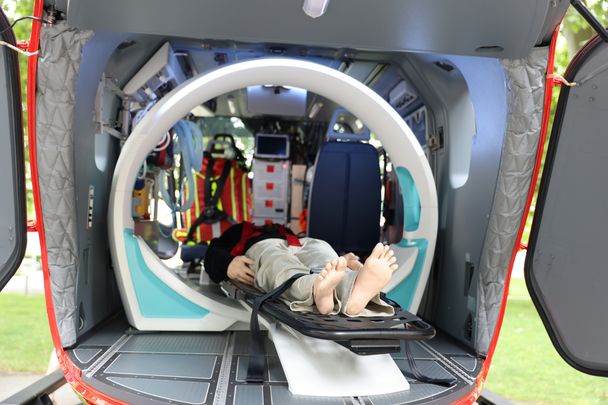Norwegian Air Ambulance Foundation and Airbus prepare for the future of HEMS

Copyright of banner image: Airbus Helicopters - Anthony Pecchi
The Norwegian Air Ambulance Foundation was the very first operator to receive the new five-bladed H145 at the end of 2020. In close collaboration with Airbus, the Foundation uses it for various research projects all aimed at improving Helicopter Emergency Medical Services (HEMS) in Norway.
For more than 40 years, the Norwegian Air Ambulance Foundation has been working on providing new and innovative air ambulance solutions. With backing from more than 300,000 support members and companies, the Foundation acquired the new five-bladed H145. Working closely with Airbus, the Foundation is using it for research, development, and training with the goal of improving HEMS services.
“We aim to save more lives and improve the health of patients. Helicopter emergency services bring the hospital to the patient – wherever they are at the time of critical illness or injuries – and we are constantly working on ways to make it even better,” explains Hans Morten Lossius, Secretary General of the Norwegian Air Ambulance Foundation.
“This Research & Development helicopter is a game-changer for what we can accomplish – not only in Norway, but also in collaboration with other relevant international partners. As far as we know, it is the only helicopter in the world dedicated to HEMS improvement alone. It allows us to conduct testing on new procedures and equipment, collect data for our research projects and provide training without relying on rotating a helicopter out of the emergency services,” Lossius adds.
Smart ideas for improving patient care in the air
The Foundation is made up of more than 120 employees ranging from medical researchers, engineers, designers and HEMS crew members with many ongoing projects looking at specific ways to improve HEMS. Even Wollo, an industrial designer who has worked for more than five years for the Foundation, explains how many of these projects start:
“We have what we call a “SmartLAB”, where we collect improvement ideas from people working in the different areas of our air ambulance service. They range from developing a new rescue helmet and modular flight suits, to creating VR-training to improve patient treatment and apps that allow dispatch centers and doctors to see the emergency site and the patient’s injuries via video link.
Parallel to the SmartLAB projects, we work on strategic development projects such as tailoring the medical cabin to the work of the physician in order to improve safety and enable the best critical care possible. We are even working on concepts for CT scanning compatibility with the helicopter emergency service and remote emergency sites.
Airbus has been a close partner during the Foundation’s research and development. Wollo explains, “It is through this collaboration, workshops and continuous exchange of experience regarding medical operations that Airbus Helicopters is able to improve existing systems. In addition, the experience and feedback gained can also influence future developments.”

Copyright: Naria Frantsen
Medical care challenges for rural environments
Norway - a country known for its beautiful nature, endless fjords and magical lakes - is also challenging when it comes to providing fast emergency care for people living in rural areas.
“Per year, there are around 15,000 stroke patients in Norway. Many of them live in the countryside, where the nearest hospital with a CT scanner is far away,” explains Wollo. “Our mission is to bring the hospital to the patient, and the only diagnostic tool for stroke is a CT scanner. So we needed to bring the CT to the patient. First, we built a special mobile stroke unit manned with a similar crew to the air ambulance service. Our research proved that diagnosis and treatment could be done before arriving at the hospital. Time is critical after a stroke so every minute is crucial for getting the right care and improving the outcome. Now we are working on concepts for putting a CT scanner into our five-bladed H145. Our aim is to give the patient the same treatment whether they live in a city or the countryside.”
Adding high-tech medical equipment to the five-bladed H145
When implementing new equipment into a helicopter, weight is one of the most important factors. “A conventional CT scanner weighs more than 200 kg, even if you remove everything that is not 100% necessary. In addition, it has a lot of moving parts, is fragile and needs a lot of space. Currently we are looking at the on-going development of CT-scanners using nano technology. This new technology has fewer and no moving parts and weighs much less. It is also more robust and could cope with prehospital use better than conventional technology. We believe it is possible to install this type of CT scanner in a helicopter.”
For integrating this high-tech equipment, a lot of knowledge about the helicopter is essential. “The colleagues at Airbus have been great in supporting us with 3D models and measurements of the helicopter. Also, the knowledge about the architecture of the helicopter has helped us to find the right areas to install our devices in the cabin.” Wollo adds that the five-bladed H145 is also well suited for these missions because of its smooth ride and experience on-board. “We hope to have the CT scanner implemented into our test-helicopter in the next four to five years.”

Copyright: Airbus Helicopters - Ralf Nicolai


